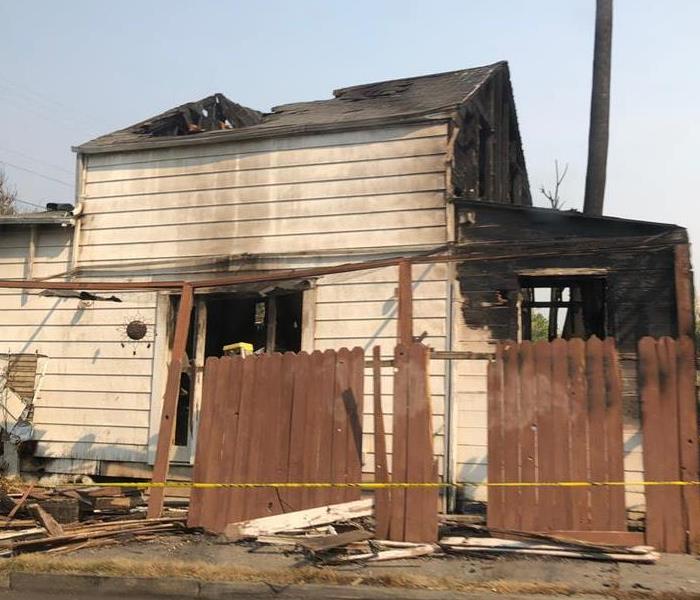Wildfire Safety Tips for California Residents Part 2
1/3/2018 (Permalink)
The new year has started, and with it should be taking proactive steps to help prevent fires - both in the home from kitchen accidents and electrical shorts to threats from outside the home that result in wildfires. The end of 2017 saw massive wildfires in Napa Valley and Sonoma counties, Ventura county, and Los Angeles as we wrote about in Part 1 of this blog post. Let’s learn our lesson and do what we can to prevent and minimize fire damage where we live and where SERVPRO of Palo Alto serves: Palo Alto, Menlo Park, Atherton and Redwood City in Santa Clara County, California.
Because weather conditions are drier and hotter every year, and because many people are careless with their cigarettes and bonfires, fire damage in California becomes a reality for many California residents of Santa Clara county. Almost 70,000 wildfires occurred in the United States just in the last two years, destroying over 4,000 standing structures, including businesses and homes. You can’t necessarily fight back an out-of-control wildfire that’s threatening your home or business, but you can take steps to protect yourself and your property.
In addition to the top 7 ways to prep for a home fire - which includes installing the correct number of smoke alarms, teaching children about smoke alarm protocol, having at least two escape routes from your home in the case of a fire, and practicing escaping at least twice a year - the Red Cross gives you these wildfire-specific tips that you can use in the case of wildfires in Palo Alto, Menlo Park, Atherton and Redwood City in Santa Clara County, California.
These are important steps you can take to help reduce the risk of fire damage and smoke or soot damage to your home from a wildfire, such as those that have recently burned in both Northern California and Southern California.
Before a Wildfire
Defend your property in the case of a wildfire. One of the first steps you limiting the fire fuel sources around your home or business.
30 Feet or less from your property
- Clear combustible materials such as dried leaves and pine needles.
- Cut down any tree limbs that are 15 feet or closer to the ground. This helps prevent the fire from spreading into your property’s tree line.
- Remove any vines or vegetation that is on the side of your structure or property.
- Store any flammable lawn furniture during the off season.
- Choose non-flammable decor for your landscaping, such as gravel instead of wood chips.
Within 100 to 30 feet from your property
- Create “fuel breaks” in your property. Fuel breaks can help stop the spread of a fire. Examples are gravel pathways or driveways.
- Cut any trees branches that are 8 feet or closer to the ground.
- Clear combustible vegetation.
Within 200 to 100 feet from your home
- Place stacked firewood or scrap wood no closer to your property line.
- Continue to clear combustible vegetation.
- Plant trees far enough apart so their branches do not touch, and trim branches that do touch.
- Prepare your home or business for a wildfire. If possible, use Class A roofing material. This includes tile, slate, or asphalt. You can also use Class B pressure-treated shingles or shakes.
- Consider installing fire sprinklers. In some areas, fire sprinklers are mandatory for businesses.
Outside your home, make sure your garden hose is long enough have enough to reach any part of your property. Make sure that the fire department can access water sources such as swimming pools, ponds, lakes, wells, and fire hydrants.
Create an emergency escape plan. Speak to city or county officials to learn what the evacuation route is for your area, and discuss this evacuation route with everyone in your family and your employees. Ensure family members who live nearby know the route and have means of transportation. Also, sign up for emergency text or alert messages from your city or neighborhood. And importantly, don’t forget to create an emergency kit.
During a Wildfire
- Prepare to evacuate.
- Listen to emergency channels or follow your city’s social media to keep up on the status of the fire.
- Keep your emergency kit handy so you can evacuate quickly.
After a Wildfire
- Return to your home or business only when it is safe, and when officials declare it safe to do so.
- Watch out for ash pits and hot spots. These are holes filled with hot ashes left by burned trees. Even after a fire is extinguished, small fires can flare up without warning.
- Check your house and surrounding property for hot spots and extinguish them immediately. Also, be on the lookout for ash pits.
- Document the damage. Take photos and video and make a written list documenting your damaged property. Contact your insurance company immediately to report the damage.
- Call a respected restoration company like SERVPRO of Palo Alto to help mitigate fire damage, smoke damage, soot damage, and water damage quickly, professionally, and efficiently.
Wildfires are some of the most destructive forces of nature. There isn’t much that can be done to deter a wildfire’s path. But luckily, there are ways to help mitigate fire damage, smoke and soot damage, and water damage from fire-fighting efforts to keep your loved ones and employees safe.
If you already have suffered fire damage and need fire restoration or smoke and soot restoration, please call SERVPRO of Palo Alto at (650) 800-3448 for a free estimate. Our highly trained technicians use advanced equipment to make it “Like it never even happened.”



 24/7 Emergency Service
24/7 Emergency Service
